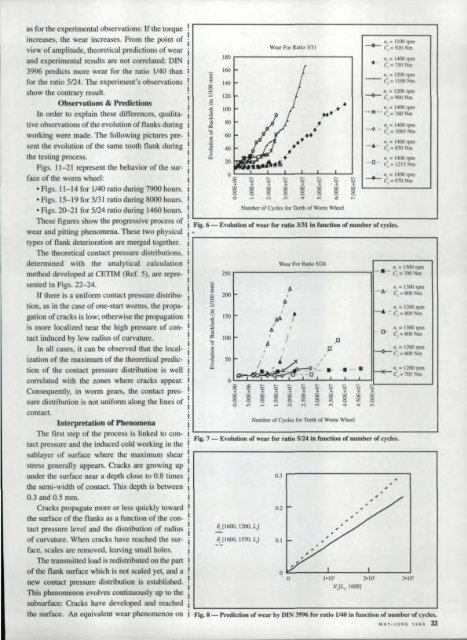Download the May/June 1998 Issue in PDF format - Gear ...
Download the May/June 1998 Issue in PDF format - Gear ...
Download the May/June 1998 Issue in PDF format - Gear ...
You also want an ePaper? Increase the reach of your titles
YUMPU automatically turns print PDFs into web optimized ePapers that Google loves.
as for <strong>the</strong> experimemal observations: If <strong>the</strong> torque<br />
<strong>in</strong>creases, <strong>the</strong> wear <strong>in</strong>creases, From <strong>the</strong> po<strong>in</strong>t of<br />
view of amplitude, <strong>the</strong>oretical predictions of wear<br />
and experimental, results are not correlated: DIN<br />
3996 predicts more wear for <strong>the</strong> ratio I140 than<br />
for <strong>the</strong> ratio 5/24. The experiment's observations<br />
show <strong>the</strong> contrary result.<br />
Observations<br />
Interpretanon<br />
& Predictions<br />
In order to ,expla<strong>in</strong> <strong>the</strong> e differences, qualitative<br />
observations of <strong>the</strong> evolution of flanks dur<strong>in</strong>g<br />
work<strong>in</strong>g were made, The follow<strong>in</strong>g pictures present<br />
<strong>the</strong> evolution of <strong>the</strong> same tooth flank: dur<strong>in</strong>g<br />
<strong>the</strong> test<strong>in</strong>g<br />
process,<br />
Figs. 11-21 represent<strong>the</strong> behavior of <strong>the</strong> surface<br />
of <strong>the</strong> worm<br />
wheel:<br />
.•Figs, 11-14 for U40 ratio dur<strong>in</strong>g 7900 hours.<br />
• Figs. 15-19 for .3/3] ratio dur<strong>in</strong>g 8000 hours.<br />
• Figs. 20-21 for 5/24 ratio dur<strong>in</strong>g 1460 hours.<br />
These figures show <strong>the</strong> progressive process of<br />
wear and pitt<strong>in</strong>g phenomena, These two physical<br />
types of flank deterioration are merged toge<strong>the</strong>r.<br />
The <strong>the</strong>oretical contact pressure distributions.<br />
determ<strong>in</strong>ed with <strong>the</strong> analytic.al.calculation<br />
method developed at CETIM (Ref, 5), are represented<br />
<strong>in</strong> Figs. 22-24.<br />
lf<strong>the</strong>re is a uniform contact pressure distribution,<br />
as <strong>in</strong> <strong>the</strong> case of one-start worms,<br />
of Phenomena<br />
<strong>the</strong> propagation<br />
of cracks is low; o<strong>the</strong>rwise <strong>the</strong> propagation<br />
is more localized near <strong>the</strong> ltigh pressure of contact<br />
<strong>in</strong>duced by low radius of curvature,<br />
In all cases, it can be observed that <strong>the</strong> localization<br />
of <strong>the</strong> maximum of <strong>the</strong> <strong>the</strong>oretical prediction<br />
of <strong>the</strong> contact pressure distribution is well<br />
correlated with <strong>the</strong> zones where cracks appear.<br />
Consequently. <strong>in</strong> worm gears, <strong>the</strong> contact pressure<br />
distribution is not uniform along <strong>the</strong> l<strong>in</strong>es of<br />
contact.<br />
The first step of <strong>the</strong> process is l<strong>in</strong>ked to contact<br />
pressureand <strong>the</strong> <strong>in</strong>duced cold work<strong>in</strong>g <strong>in</strong> <strong>the</strong><br />
sublayer of surface where tile maximum shear<br />
tress generally appears. Cracks are grow<strong>in</strong>g up<br />
under <strong>the</strong> surface near a depth close to 0.8 times<br />
<strong>the</strong> semi-width of contact. This depth is between<br />
0.3 and 0.5 nun.<br />
Cracks propagate more or less quickly toward<br />
<strong>the</strong> surface of <strong>the</strong> flanks as a function of <strong>the</strong> contact<br />
pressure level and <strong>the</strong> distribution of radius<br />
of curvature. When cracks have reached <strong>the</strong> surface,<br />
scales are removed, leav<strong>in</strong>g small holes.<br />
The transmitted load is redistributed on <strong>the</strong> part<br />
of<strong>the</strong> flank surface which is not scaled yet, and a<br />
new contact pressure distribution is established.<br />
This phenomenon evolves cont<strong>in</strong>uously up to <strong>the</strong><br />
sub urface: Cracks have developed and reached<br />
180<br />
160<br />
~ 140<br />
8<br />
- 12(1<br />
!<br />
""<br />
100<br />
!!<br />
:;;;<br />
'u' 80<br />
CQ<br />
...<br />
0<br />
60<br />
III<br />
·0<br />
4(1<br />
:.-<br />
~<br />
20<br />
Wear For Ralio 3/31<br />
o~ ... ..... 't-<br />
';<br />
III ~ ~<br />
8 a ~ 8 a<br />
ci .. ...<br />
,.;<br />
Number of Cycles for Teeth of Wonn Wheel<br />
-1(- n, ~ 1100 rpm<br />
- C, ~920Nm<br />
n,=I400rpm<br />
• C, ~ 750Nm<br />
_ n, = 1200 rpm<br />
-- C,=IIOONm<br />
n ~ 1200 rpm<br />
-e- C,=900Nm<br />
n, = 1400rpm<br />
..*..C,=760Nm<br />
n, = 1400 rpm<br />
--0 - C,= 1065 Nm<br />
" = 1400 rpm<br />
-&-, C,= 850 Nm<br />
, ", = 1400 rpm<br />
0- C,=12ISNm<br />
<strong>the</strong> surface. An equivalent wear phenomenon on Fig. 8 - Prediction of wear by om 1996 for ratio 1140lioruotioo of number of ,cycles.<br />
MAY/JUNE '<strong>1998</strong> 33<br />
_<br />
~, = 1.400rpm<br />
C,=970Nm<br />
!Fig•.6 - Evolution, of wear for ratio 113] <strong>in</strong> function of numlle.r of cycles ..<br />
Wear For RaLio 5124<br />
" = 1500 rpm<br />
.- C, .. 700 Nm<br />
250 I<br />
i f,I. I,-llt n, = 1300 rpm<br />
8 200 . I I C,=SIXlNm<br />
- f n, = 1200 rpm<br />
g I .,<br />
r-C,= 800 Nm<br />
.d 150<br />
~<br />
f<br />
:;;;!<br />
~<br />
/ CI ", = 1500 rpm<br />
~<br />
"'.<br />
- ,- C, .. 600 Nm<br />
j;Q<br />
I<br />
100 -<br />
'0 /<br />
,.0,<br />
~<br />
III<br />
I ", = 1200 rpm<br />
I<br />
J1<br />
·0<br />
;---0--- C, = 600 Nm<br />
I I<br />
::I<br />
50 =<br />
,<br />
"6<br />
:- ,<br />
i<br />
III ,<br />
/-.<br />
" • ...- i. 'I- I--X_" = 1200 rpm<br />
a;! ~ --[] C,=705 Nm<br />
. ,<br />
0<br />
e-<br />
~ ~ I ~ ~ ~ r-. e- ~<br />
~ ~ ~<br />
Ltl III I!:l<br />
., .,<br />
8 "1 8 ~ a.., .., "l<br />
~ ~ a<br />
ci ..;<br />
- - ..<br />
'"<br />
Number of Cyctes for Teeth of Wonn Wheel<br />
F.ig. 7 - Evolution of wear for ratio 5/24 .In function of number of cycles.<br />
0, [1,600, 1200, L,l<br />
0, [1600. 1570. LJ 0.1<br />
0.3 I<br />
I<br />
o<br />
1'10' 2'10' )'10'<br />
'"<br />
I<br />
I<br />
,<br />
I

















